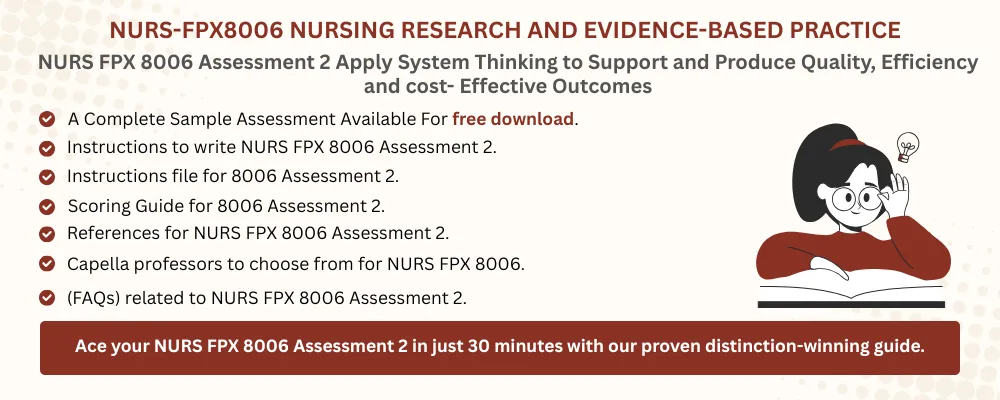NURS FPX 8006 Assessment 2 FREE DOWNLOAD
NURS FPX 8006 Assessment 2
Apply System Thinking to Support and Produce Quality, Efficiency, and Cost-Effective Outcomes
Student Name
Capella University
NURS-FPX8006
Professor Name
Submission Date
Slide 1:
Apply System Thinking to Support and Produce Quality, Efficiency, and Cost-Effective Outcomes
Hi, my name is and I will explore the topic of fall prevention in elderly hospital patients through the lens of an interprofessional team that is based on the systems theory. My theoretical background applies the theory of complex adaptive systems (CAS) in contextualizing collaborative approach.
Slide 2
Introduction
Falls in hospitals lead to severe injuries and increased costs as well as lengthy hospital stays. The prevention should be carried out through collaboration between nurses, physical therapists, pharmacists, and geriatric specialists (Ojo & Thiamwong, 2022). The CAS theory gives the theoretical background, showing how teams in healthcare change dynamically to improve patient care (Notarnicola et al., 2024).
The presentation will focus on quality management, interprofessional collaboration, process improvements, and economic gains of different provider perspectives. The presentation will demonstrate the ways in which research-based, team-based strategies can reduce the number of falls, enhance patient safeguarding, and streamline healthcare delivery systems. To ensure that the risks are well managed, healthcare facilities should develop multifaceted and team-based fall prevention strategies.
Slide 3
Quality & Outcome Management – Provider Perspectives
Each of the healthcare team members has a unique role to play in quality improvement and outcome management. The top priorities of nurses are patient safety that is achieved by assessing fall risks, frequent rounding, and educative preventive strategies (Lozoya et al., 2020). Physical therapists are concerned with the improvement of mobility, strengthening, and the evaluation of walking patterns to reduce the risk of falls (Sadaqa et al., 2023).
Pharmacists examine drugs in order to recognize those that lead to dizziness or blood pressure drops (White, 2021). Geriatricians construct individualized and inclusive plans of care to suit the fall prevention requirements of every older adult. The interdependent functions need cooperation and sharing of information to provide care on an efficient basis. An integrated interprofessional care will improve the patient outcomes, as it will thoroughly address the various determinants of fall risk.
Slide 4
Negotiating a Collaborative System Approach
Medical personnel must deal with the constraints of healthcare operations and practice delimitations in the effort to develop fall prevention procedures. The theory of complex adaptive systems states that the healthcare team is a multilateral network where the performance of individual team members is the driving force behind the success of the entire system (Glover et al., 2020).
The negotiation success of the team involves the assent of all parties on the fall risk reduction levels as they select the commonly accepted evaluation methodologies and develop the specific performance requirements. To make decisions, healthcare leaders ought to compare resource allocation and the evidence-based practice that produces quantifiable results (Seixas et al., 2021). The collaborative negotiation process helps healthcare organizations create responsive systems which are effective in managing the various factors which contribute to fall risk situations.
Slide 5
Supporting Outcomes Across the Continuum of Care
The collaborative system approach facilitates comprehensive treatment outcomes to the patients via patient-centered care by bringing together professionals of various disciplines working together at the onset to the end of a patient journey. Risk assessment standards along with team interventions ensure that healthcare staff is better equipped to deal with the various causes of fall risks compared to when teams are functioning in isolation (Emeric et al., 2024).
By means of the integrated approach, care providers have consistent documentation and flow of communication between treatment settings, thereby eliminating care transition shortcomings. The studies show that when healthcare professionals work in collaboration, the number of patient falls decreases dramatically, and patients are more mobile and confident (Baumann et al., 2022). The strategy will develop improved healthcare continuity by minimizing the costs incurred in addressing medical complications caused by falls.
Slide 6
Efficiency & Process Improvement
Standardized risk assessment instruments enable effective evaluation of patients due to the common professional language and reduce repetitive patient screening. The real-time exchange of fall risk information and the results of the interventions among the team members is easy with the help of integrated electronic documentation systems, improving the coordination of the care (Moskowitz et al., 2020).
Frequent interprofessional huddles aimed at high-risk patients reduce the communication barrier and guarantee that the personalized approach to fall prevention is implemented in a timely manner. Automated reporting of fall incidents and near-misses centralizes the tracking of these events and determines where the system has problems that need adjustments to the protocols (Yao & Lu, 2024). Pharmacist-led medication reviews that are scheduled before appointments with a therapist to evaluate therapy are a way of optimizing resources and offer complete management of fall risks.
Slide 7
Cost Management & Return on Investment
The initial cost of standardized assessment tools and staff training on these tools will be recovered in 3-5 years due to the decreased number of fall-related hospitalizations and the length of stay. The overall strategy has more and more returns in a 5-10-year period since the prevention strategies not only minimize direct treatment costs but also minimize the long-term rehabilitation costs. The cost-effectiveness of community-based exercise programs and medication management protocols is manifested in patient independence and the postponement of expensive institutional care (Pinheiro et al., 2022).
The elements of family education establish lasting support systems that have the capacity of sustaining professional care beyond clinical environments. The net cost avoidance due to implementation of the evidence-based fall prevention program was $14,600 per 1000 patient days (Dykes et al., 2023). The economic advantages become realized in terms of the reduction of healthcare spending, which, at the same time, increases the level of patient protection and health.
Slide 8
Conclusion
Interdisciplinary interventions in fall prevention combines the knowledge of nurses, physical therapists, pharmacists, and geriatricians to deal with the multifactorial nature of causing falls in patients.
The introduction of standardized assessment tools, frequent interprofessional communication, and intervention planning contributes to a complete system that will minimize the number of fall incidents to a significant extent. The cost of the initial training and resources investment is well worth it with reduced hospitalizations and rehabilitation costs. The collaborative model is not only patient safety and mobility friendly but is also a way of enhancing healthcare efficiency as operations are streamlined and redundancy is reduced.
Related Free Assessments for NURS-FPX8006
Instructions To Write NURS FPX 8006 Assessment 2
If you need step-by-step instructions to complete this assessment, contact us and our expert tutor will guide you.
Instructions File For 8006 Assessment 2
Contact us to get the instruction file for this assessment.
Scoring Guide for 8006 Assessment 2
Contact us to get the Scoring file for this assessment.
References For NURS FPX 8006 Assessment 2
Baumann, I., Wieber, F., Volken, T., Rüesch, P., & Glässel, A. (2022). Interprofessional collaboration in fall prevention: Insights from a qualitative study. International Journal of Environmental Research and Public Health, 19(17), 10477. https://doi.org/10.3390/ijerph191710477
Dykes, P. C., Bowen, M. C., Lipsitz, S., Franz, C., Adelman, J., Adkison, L., Bogaisky, M., Carroll, D., Carter, E., Herlihy, L., Lindros, M. E., Ryan, V., Scanlan, M., Walsh, M.-A., Wien, M., & Bates, D. W. (2023). Cost of inpatient falls and cost-benefit analysis of implementation of an evidence-based fall prevention program. Journal of the American Medical Association Health Forum, 4(1), e225125. https://doi.org/10.1001/jamahealthforum.2022.5125
Emeric, C. S. C., McDermott, C. L., Lee, D. S., & Berry, S. D. (2024). Risk assessment and prevention of falls in older community-dwelling adults: A review. Journal of the American Medical Association, 331(16). https://doi.org/10.1001/jama.2024.1416
Glover, W. J., Nissinboim, N., & Naveh, E. (2020). Examining innovation in hospital units: A complex adaptive systems approach. BioMedical Central Health Services Research, 20(1). https://doi.org/10.1186/s12913-020-05403-2
Lozoya, R. M., Montoya, I. M., Caballero, V. G., López, M. I. M., Hontangas, A. R., & Lucas, R. O. (2020). Impact of nurses’ intervention in the prevention of falls in hospitalized patients. International Journal of Environmental Research and Public Health, 17(17), 6048. https://doi.org/10.3390/ijerph17176048
Moskowitz, G., Egorova, N. N., Hazan, A., Freeman, R., Reich, D. L., & Leipzig, R. M. (2020). Using electronic health records to enhance predictions of fall risk in inpatient settings. The Joint Commission Journal on Quality and Patient Safety, 46(4), 199–206. https://doi.org/10.1016/j.jcjq.2020.01.009
Notarnicola, I., Lommi, M., Ivziku, D., Carrodano, S., Rocco, G., & Stievano, A. (2024). The nursing theory of complex adaptive systems: A new paradigm for nursing. Healthcare, 12(19), 1997–1997. https://doi.org/10.3390/healthcare12191997
Ojo, E. O., & Thiamwong, L. (2022). Effects of nurse-led fall prevention programs for older adults: A systematic review. Pacific Rim International Journal of Nursing Research, 26(3), 417. https://pmc.ncbi.nlm.nih.gov/articles/PMC9432804/
Pinheiro, M. B., Sherrington, C., Howard, K., Caldwell, P., Tiedemann, A., Wang, B., S Oliveira, J., Santos, A., Bull, F. C., Willumsen, J. F., Michaleff, Z. A., Ferguson, S., Mayo, E., Fairhall, N. J., Bauman, A. E., & Norris, S. (2022). Economic evaluations of fall prevention exercise programs: A systematic review. British Journal of Sports Medicine, 56(23), 105747. https://doi.org/10.1136/bjsports-2022-105747
Sadaqa, M., Németh, Z., Makai, A., Prémusz, V., & Hock, M. (2023). Effectiveness of exercise interventions on fall prevention in ambulatory community-dwelling older adults: A systematic review with narrative synthesis. Frontiers in Public Health, 11(11). https://doi.org/10.3389/fpubh.2023.1209319
Seixas, B. V., Regier, D. A., Bryan, S., & Mitton, C. (2021). Describing practices of priority setting and resource allocation in publicly funded health care systems of high-income countries. BioMedical Central Health Services Research, 21(1), 1–15. https://doi.org/10.1186/s12913-021-06078-z
White, N. D. (2021). Mitigating medication-related fall risk through pharmacist–prescriber collaboration. American Journal of Lifestyle Medicine, 15(6), 602–604. https://doi.org/10.1177/15598276211035361
Yao, C. B., & Lu, C. T. (2024). Dynamic tracking and real-time fall detection based on intelligent image analysis with convolutional neural network. Sensors, 24(23), 7448. https://doi.org/10.3390/s24237448
Best Professors To Choose From For 8006 Class
- Erica Alexander, DNP, MSN.
- Jill Aston, DNP, MSN, BSN.
- Jennifer Carroll, DNP, MSN.
- Ruth Ellen Yeager, DNP, MSN, BSN.
- Elisea Avalos, DNP, MSN.
(FAQs) related to NURS FPX 8006 Assessment 2
Question 1: From where can I download a free sample for NURS-FPX 8006 Assessment 2?
Answer 1: You can download a free sample for NURS-FPX 8006 Assessment 2 from the Tutors Academy website.
Do you need a tutor to help with this paper for you with in 24 hours.
- 0% Plagiarised
- 0% AI
- Distinguish grades guarantee
- 24 hour delivery

